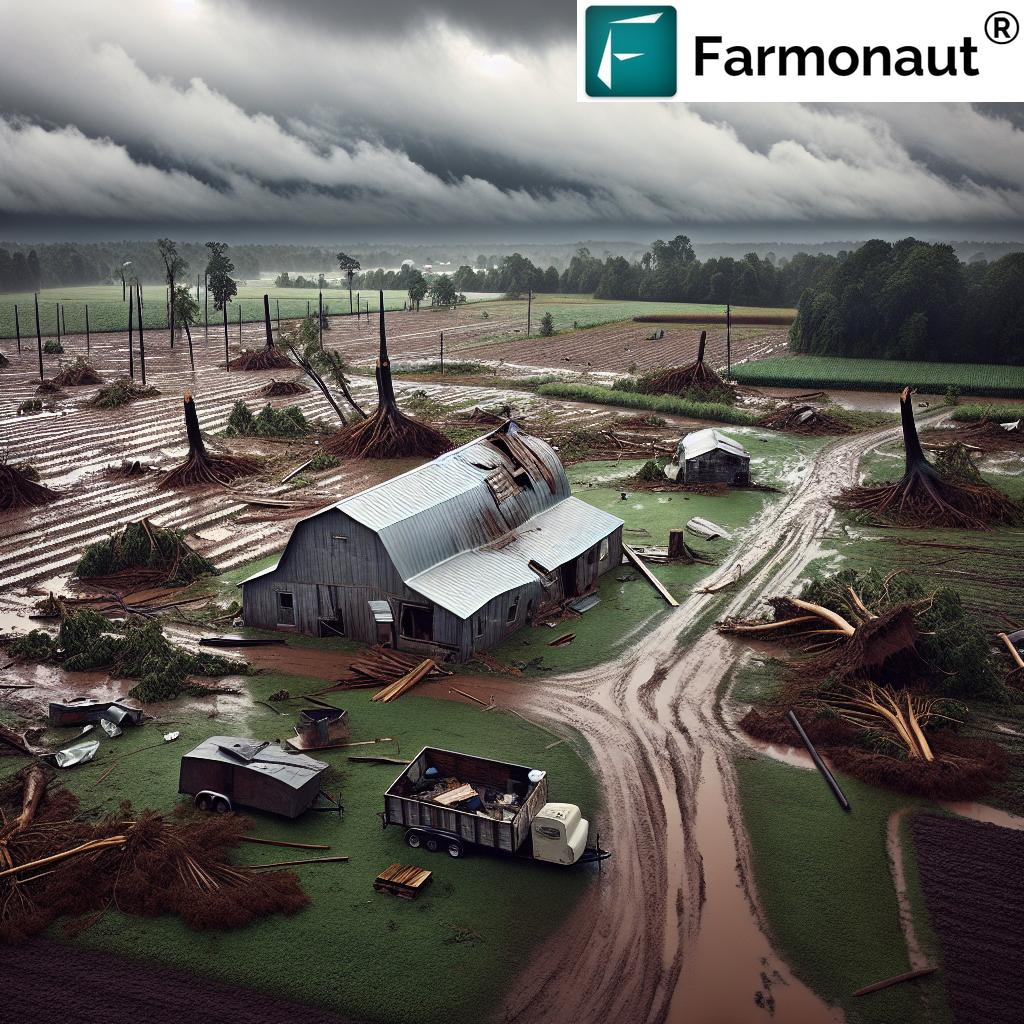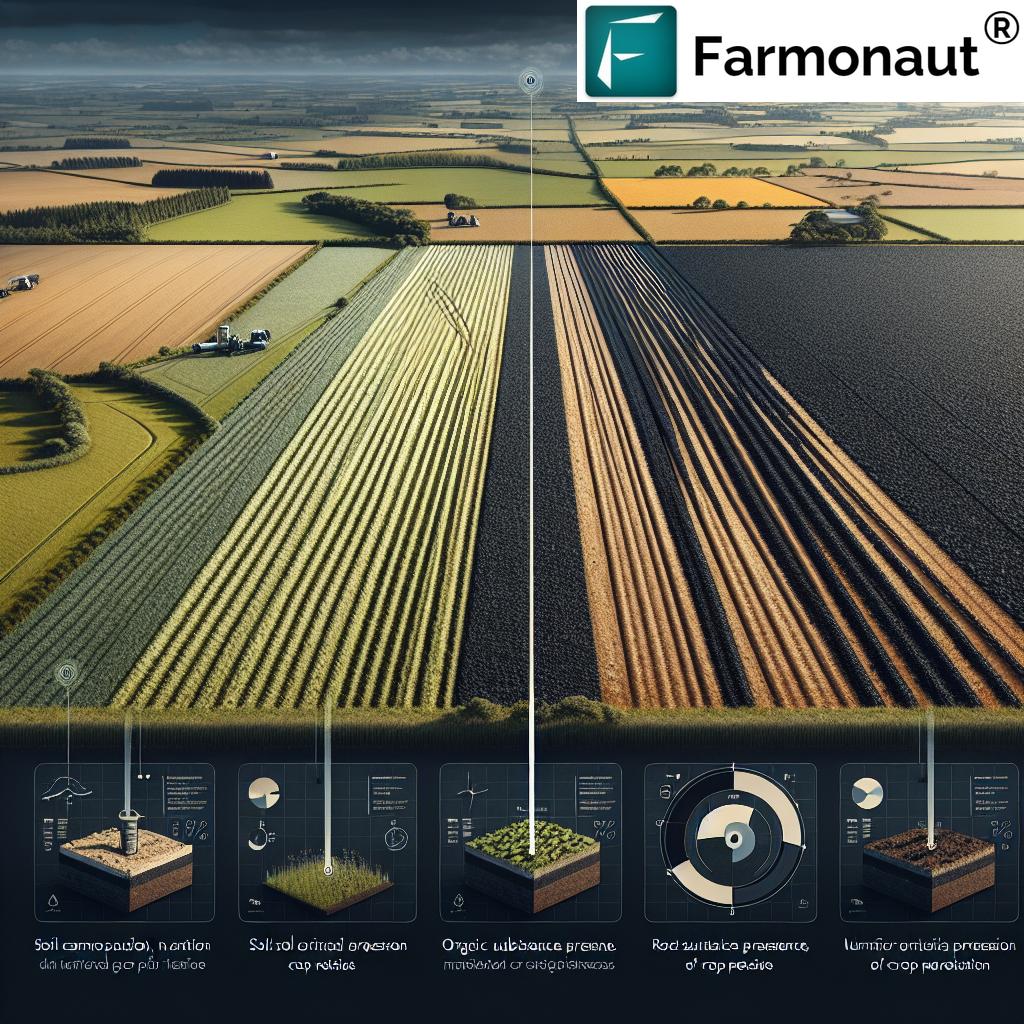Farmonaut Insights: Hurricane Helene’s Devastating Impact on Georgia’s Farmworkers – A Call for Agricultural Resilience
“Hurricane Helene’s impact on Georgia left thousands of farmworkers facing unemployment, with crop losses estimated in millions of dollars.”
As we delve into the aftermath of Hurricane Helene’s devastating impact on Georgia’s agricultural community, we are confronted with a stark reality that demands our attention and action. The recent catastrophe has laid bare the vulnerabilities of our farmworkers, particularly in Lake Park, Georgia, where the storm’s fury has left an indelible mark on the lives of those who form the backbone of our food supply chain.

In this comprehensive analysis, we at Farmonaut will explore the multifaceted challenges faced by farmworkers in the wake of this natural disaster, examining the intersection of climate change and agriculture, the socio-economic implications of storm damage, and the urgent need for enhanced agricultural community resilience. Our focus will be on understanding the hurricane’s impact on agriculture and the complex issues surrounding farmworker disaster relief.
The Eye of the Storm: Hurricane Helene’s Arrival
On September 27, Hurricane Helene made landfall in south Georgia, bringing with it winds of up to 130 mph and torrential rain. The storm’s path cut through the heart of Georgia’s agricultural belt, leaving a trail of destruction that would profoundly affect the lives of thousands of farmworkers and their families.
Lake Park, a small community near the Florida border, bore the brunt of Helene’s wrath. Here, we witnessed firsthand the devastating effects of agricultural storm damage as fields were flooded, crops were destroyed, and the livelihoods of farmworkers were literally uprooted overnight.
The Human Face of Disaster: Gloria and Ramón’s Story
To truly understand the impact of this catastrophe, we must look beyond the statistics and into the lives of those affected. Gloria and Ramón, an undocumented immigrant couple with three children, exemplify the plight of many farmworker families in the region.
- Their trailer home was severely damaged by falling trees
- The family faced immediate danger during the storm
- Post-hurricane living conditions were drastically compromised
- Extended periods without power, water, or proper shelter ensued
Their story is not unique. Countless farmworker families in Lake Park and surrounding areas found themselves in similar dire straits, grappling with the immediate threat to their safety and the long-term implications for their livelihoods.
Agricultural Storm Damage: A Closer Look
The agricultural landscape of Georgia was transformed overnight by Hurricane Helene. The storm’s impact on agriculture was profound and far-reaching:
- Crop loss from natural disasters was extensive, with entire fields submerged or destroyed
- The estimated damage to agriculture and forestry industries in Georgia reached a staggering $6.5 billion
- Farm labor after hurricanes became scarce as fields were rendered unworkable
- The peak harvest season was disrupted, leading to significant economic losses
These impacts rippled through the entire agricultural ecosystem, affecting not just the immediate harvest but potentially future growing seasons as well.
The Plight of Farmworkers: Unequal Impact and Limited Relief
As we examine the aftermath of Hurricane Helene, it becomes clear that farmworkers, especially those from immigrant communities, bear a disproportionate burden of the disaster’s consequences:
- Many farmworkers faced prolonged unemployment due to field damage
- Undocumented workers often hesitated to seek assistance for fear of deportation
- Language barriers and isolation complicated access to disaster relief information
- The distribution of aid was often inequitable, favoring urban centers over rural communities
The challenges in disaster recovery for farmworkers highlight systemic issues within our agricultural and social support systems. These hardworking individuals, crucial to our food supply, often find themselves in a precarious position when natural disasters strike.
Climate Change and Agriculture: A Growing Threat
Hurricane Helene’s devastating impact serves as a stark reminder of the increasing vulnerability of our agricultural communities to extreme weather events. As climate change continues to alter weather patterns, we can expect:
- More frequent and intense hurricanes affecting coastal and inland farming regions
- Unpredictable rainfall patterns leading to droughts or floods
- Shifting growing seasons that disrupt traditional planting and harvesting cycles
- Increased pest and disease pressures on crops due to changing climatic conditions
These weather impacts on farming necessitate a reevaluation of our agricultural practices and the development of more resilient farming systems.

The Role of Technology in Disaster Preparedness
In the face of these challenges, farm technology for disaster preparedness becomes increasingly crucial. At Farmonaut, we recognize the importance of leveraging advanced technologies to mitigate risks and enhance agricultural resilience:
- Satellite-based crop monitoring for early detection of potential issues
- AI-driven weather forecasting to improve preparedness for extreme events
- Precision agriculture techniques to optimize resource use and crop resilience
- Blockchain-based systems for efficient and transparent disaster relief distribution
By integrating these technologies, we can better equip farmers and farmworkers to face the challenges posed by climate change and natural disasters.
Explore Farmonaut’s cutting-edge agricultural solutions:
Farmworker Disaster Relief: Challenges and Opportunities
The aftermath of Hurricane Helene has highlighted significant gaps in farmworker disaster relief efforts:
- Limited access to federal aid for undocumented workers
- Inadequate information dissemination in rural, non-English speaking communities
- Lack of temporary housing solutions for displaced farmworker families
- Insufficient mental health support for those dealing with trauma and loss
Addressing these challenges requires a multi-faceted approach involving government agencies, non-profit organizations, and the agricultural industry itself.
“Climate change-induced extreme weather events threaten over 2.5 million farmworkers in the US, highlighting the need for agricultural resilience.”
Building Agricultural Community Resilience
In the wake of Hurricane Helene, the concept of agricultural community resilience has taken on new urgency. We must focus on:
- Developing comprehensive disaster preparedness plans specific to agricultural communities
- Creating robust support networks that include farmworkers in decision-making processes
- Implementing sustainable farming practices that enhance soil health and water management
- Investing in education and training programs to diversify skills within farming communities
By strengthening these communities, we can better withstand future challenges and ensure the continuity of our food production systems.
The Path Forward: Policy Recommendations and Industry Action
As we reflect on the lessons learned from Hurricane Helene, it’s clear that significant changes are needed to protect our farmworker communities and enhance agricultural resilience. We propose the following recommendations:
- Expand disaster relief eligibility to include all farmworkers, regardless of immigration status
- Implement stricter building codes for farmworker housing to withstand extreme weather events
- Create a dedicated fund for farmworker emergency assistance and long-term recovery
- Develop multilingual, culturally appropriate disaster preparedness and response materials
- Invest in climate-resilient agricultural practices and infrastructure
These steps, combined with industry-led initiatives, can pave the way for a more resilient and equitable agricultural sector.
Farmonaut’s Commitment to Agricultural Resilience
At Farmonaut, we are dedicated to supporting farmers and farmworkers through innovative technology solutions. Our satellite-based crop monitoring and AI-driven advisory systems can play a crucial role in:
- Early detection of potential crop issues, allowing for timely interventions
- Optimizing resource use to build more resilient farming systems
- Providing real-time data to support informed decision-making during crises
- Facilitating efficient disaster response and recovery efforts
Discover how Farmonaut can enhance your agricultural operations: Explore our API | API Developer Docs
Impact Comparison: Hurricane Helene’s Effect on Georgia’s Agricultural Community
| Impact Area | Farmworkers | Farm Owners | Local Economy |
|---|---|---|---|
| Estimated Financial Loss ($) | 1,000 – 5,000 per household | 100,000 – 1,000,000 per farm | 6.5 billion (total) |
| Percentage Affected (%) | 80-90% | 60-70% | 40-50% |
| Recovery Time (Months) | 6-12 | 12-24 | 24-36 |
| Access to Relief Aid | Low | Medium | High |
Conclusion: A Call to Action
The devastation wrought by Hurricane Helene on Georgia’s farmworker communities serves as a clarion call for change. As we face the growing challenges posed by climate change and extreme weather events, it is imperative that we work together to build a more resilient and equitable agricultural system.
We must recognize the vital role that farmworkers play in our food security and take concrete steps to protect their rights, improve their living conditions, and ensure their access to disaster relief and recovery resources. By investing in sustainable farming practices, advanced technologies, and comprehensive support systems, we can create a future where our agricultural communities are better prepared to weather any storm.
The road ahead is challenging, but with collective effort, innovative solutions, and a commitment to social justice, we can build an agricultural sector that is not only productive but also resilient and fair for all those who work within it.
FAQ Section
Q: How can farmworkers better prepare for natural disasters?
A: Farmworkers can prepare by creating emergency kits, familiarizing themselves with local evacuation routes, and staying informed about weather conditions. Employers should provide disaster preparedness training and ensure safe housing conditions.
Q: What resources are available for undocumented farmworkers affected by disasters?
A: While federal aid may be limited, undocumented farmworkers can often access assistance from non-profit organizations, local charities, and some state-level programs that do not require proof of citizenship.
Q: How can technology help in mitigating the impact of natural disasters on agriculture?
A: Technologies like satellite imaging, AI-driven weather forecasting, and precision agriculture tools can help predict and prepare for extreme weather events, optimize resource use, and facilitate faster recovery after disasters.
Q: What long-term solutions can address the vulnerability of farmworker communities?
A: Long-term solutions include improving housing standards, diversifying local economies, providing education and skills training, and implementing climate-resilient agricultural practices.
Q: How can consumers support affected farmworker communities?
A: Consumers can support by donating to relief efforts, purchasing from farms that prioritize worker welfare, advocating for policy changes, and raising awareness about the challenges faced by farmworker communities.
As we continue to navigate the challenges posed by climate change and its impact on agriculture, it’s crucial to leverage cutting-edge technologies and data-driven insights. Farmonaut stands at the forefront of this technological revolution in agriculture, offering solutions that can significantly enhance farm management and disaster preparedness.
Our satellite-based farm management solutions provide real-time crop health monitoring, AI-based advisory systems, and resource management tools that are invaluable in today’s unpredictable climate. By utilizing these advanced technologies, farmers and agricultural businesses can better prepare for and mitigate the impacts of extreme weather events like Hurricane Helene.
Explore Farmonaut’s innovative solutions:
- Real-time crop health monitoring using satellite imagery
- AI-driven personalized farm advisory with Jeevn AI
- Blockchain-based product traceability for supply chain transparency
- Fleet and resource management tools for optimized operations
- Carbon footprinting to promote sustainable farming practices
By integrating these technologies into agricultural practices, we can work towards building more resilient farming systems that can withstand the challenges posed by climate change and extreme weather events. Farmonaut’s commitment to making precision agriculture accessible and affordable aligns perfectly with the need for enhanced agricultural resilience in the face of disasters like Hurricane Helene.
As we conclude this comprehensive analysis of Hurricane Helene’s impact on Georgia’s farmworkers and the broader implications for agricultural resilience, we invite you to explore how Farmonaut’s innovative solutions can contribute to a more sustainable and resilient future for agriculture. Together, we can work towards creating a world where our food systems are better prepared to face the challenges of tomorrow.
Remember, the path to agricultural resilience is a collective journey. By leveraging advanced technologies, advocating for fair policies, and supporting our farmworker communities, we can build a more robust and equitable agricultural sector that can weather any storm.
















